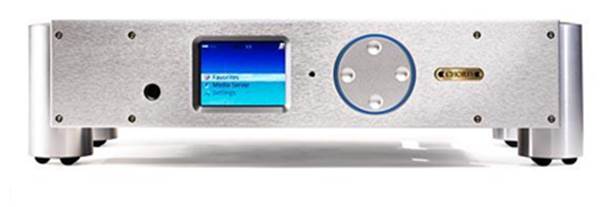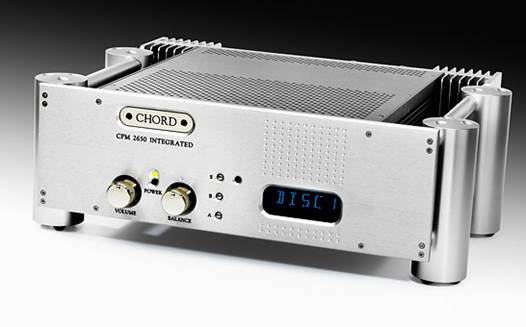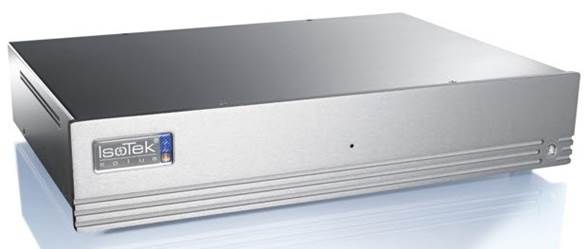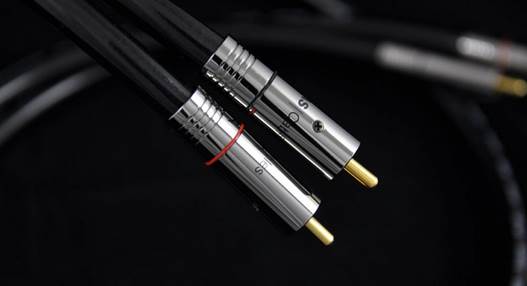The system
Chord DSX 1000 streamer ($10,500)
Brand new state-of-the-art streamer
controlled by supplied remote and Apple iPod Touch running 8Player.

Chord
DSX 1000 streamer
WD My Book Live – 2TB ($150)
Excellent affordable network attached
storage hard disk for storing music. The 3TB version costs just $75 more.

WD
My Book Live – 2TB
Chord CPM 3350 integrated amplifier
($12,825)
Superb quality one-box amp pushing out 2 x
220W RMS per channel into 8ohms. Glass-clear sound, oodles of detail

Chord
CPM 3350 integrated amplifier
IsoTek EVO 3 Aquarius power
conditioner ($1,800)
Mid-priced, six-way mains conditioning
component, offering filtered and isolated mains outputs; great for noisy mains!

IsoTek
EVO 3 Aquarius power conditioner
Niveo Professional NWAR33P router
Robust wireless router connecting DSX 1000
and NAS via Ethernet cable, and giving network for iPod touch remote control

Niveo
Professional NWAR33P router
Atlas Mavros cables ($1,125)
These high quality copper XLR interconnects
and speaker cables (single wired) give a fast, musical sound.

Atlas
Mavros cables
Monitor Audio GX200 loudspeakers
($3,450)
Super compact floor-standers with metal-
coned mid/bass units and ribbon tweeters, giving very clean and open sound

Monitor
Audio GX200 loudspeakers
Hearing believes
We ran 20 minute listening sessions,
playing four recordings at different quality levels. Just to make a point, I’d
start with a burst of a 128kbps AAC file, representative of the sort of thing
you’d get from the iTunes music store. Then I played the same recording as a
16/44 FLAC, ripped in dBpoweramp from the latest version of the CD. Lastly, the
same piece of music in hi-res, at 24-bit, 88.2 kHz resolution.
The first tune was Miles Davis’ So What.
The listeners all agreed the AAC version was poor, many talking about it as
sounding like “a cardboard copy of the music” or “just plain terrible”. Moving
to the CD-quality FLAC things got much better, with our listeners beginning to
immerse themselves in a far more three-dimensional sound. Suddenly the trumpets
hung back, and the soundstage widened. But it wasn’t until the 24/88 file had
been played that the tune sounded right; people said it was “a bit smoother and
more open”, “more lifelike” and closer to how they remember it on vinyl.
With the first track, most listeners said
the move from AAC to CD-quality was larger than from CD-quality to hi-res. But
with the next track, recorded some 15 years later at state-of-the-art Abbey
Road studios, things changed. Pink Floyd’s title track from Wish You Were Here
sounded pretty ropey on AAC, and it was clear that CD-quality really improved
on it. But still, most listeners felt CD was “pretty poor”, sounding closed-in
and a little hard and steely. Admittedly it’s not as sumptuous a recording as
the Miles track, but some folk on the front row looked positively pained! The
24/88 version was altogether much nicer though, everyone agreeing that the
stage depth was dramatically improved, and the hardness of the CD (and iTunes)
versions had gone. Suddenly you could hear right into the recording, and begin
to get a sense of the emotional poignancy of the song.
Next on was David Bowie’s early eighties
odyssey, Ashes to Ashes from the Scary Monsters album. The AAC was pure
torture, so we didn’t dwell on this long, but surprisingly the CD-quality sound
was relatively poor, too. It was clingy, steely, brittle and muddled; Bowie’s
vocal layering through the bridge of the song was unintelligible. Via 16-bit,
you’d be forgiven for thinking this was a grim recording, it really was that
bad. But moving to the hi-res produced smiles on people’s faces, and a sudden
air of relaxation in the room. Amazingly, some instruments in the mix dropped
back quite a way, the hi-res version setting up a wonderfully expansive
recorded acoustic. Bass got fuller, cymbals sweeter, and percussion sounded
less forceful, yet far more rhythmic and Bowie’s vocals hovered majestically in
space, never descending into muddle. Many listeners were quite flabbergasted by
this transformation, using words such as “amazing” and “awesome”. I asked each
audience at the end of the Miles Davis and Pink Floyd tracks whether the
improvement they’d heard would tempt them towards hi-res; usually about half
the group would say yes, but this time everyone answered in the affirmative.
The debrief
The message from the listening was clear;
some hi-res music files are better than others – all are not blessed with a
uniformly high level of pristine, glistening fidelity. That’s because they can
only be as good as the original recording, of course – something that owners of
decent vinyl systems know all too well. Still, even if a hi-res file such as the
vintage Miles Davis recording doesn’t have amazing bandwidth, power and punch,
hi-res will still make it sound more musical, lyrical and – well, you know,
natural.
Overall, everyone who took part in this
event was pretty categorical about the findings. One: iTunes sounds awful and
if you think it doesn’t then you’re fooling yourself or not used to the sound
of real music. Two: CD-quality FLAC was variable, but the better the recording
got, the worse it seemed to do; at best it was listenable, at worst it was
downright unpleasant on the ear. Three: hi-res always sounded better, but by
different amounts depending on the quality of the original recording.
Interestingly, it didn’t always sound more impressive but it did always sound
more natural, with a nice, easy rhythmic flow. Some vinyl users opined that it
still didn’t hold a candle to their LP systems, but also added they’d be happy
to listen to hi-res, but not to CD. Seconded!
The tests threw up a few issues though, the
first of which was compression. When moving from the CD-ripped file to the
hi-res, I had to turn up the volume level a bit to compensate for the
compression on the 16-bit recording. This was apparent on all the recordings we
compared, and rather depressingly underlines the amount of monkeying around
that sound engineers do in their so-called ‘re-mastering’. While it might
impress cloth-eared Q magazine album reviewers, it doesn’t do audiophiles or
indeed the music itself any good whatsoever. So another, unexpected benefit of
hi-res is that you don’t have to listen to level compression, whereas on most
modern CD reissues, tragically you do!
Finally, the vexed question of “where do
you buy hi-res files from?” reared its ugly head. The answer is – at the moment
– it depends on the artist. Right now, we’re at a stage where (rather like
SACDs and DVD-As a decade ago), you have to go and search for it. Happily, Linn
Records is now selling a number of Universal Music titles from Bob Marley to
Steely Dan and Rush, plus a useful amount of classical, too. B&W’s Society
of Sound continues with some interesting releases, not least those from Peter
Gabriel. Naim Label, Hyperion and others are also doing their bit. But after
that it’s down to the individual artists themselves; everyone from The Beatles
to Kate Bush has hi-res versions of their music on sale. There’s still a
relative paucity of top-quality digital music available right now and, although
things are improving, it’s still happening at a snail-like pace.
Overall though, hi-res music hardware and
software is cheaper and easier than it’s ever been, and more and more people
are making the move to digital streaming. As this event showed – there’s
enormous potential in this way of listening to music, and a lot of people have
noticed and are actively considering it.